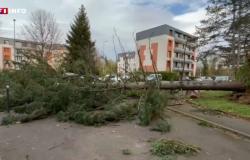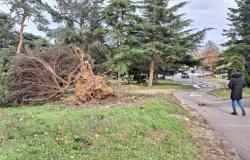“Major flood prevention works can be combined with ecological engineering.” Before receiving the grand prize of the fifth national ranking of ecological engineering, on November 20 at the mayors' salon, Philippe Lorimier, first vice-president of the joint union of hydraulic basins of Isère (SYMBHI), presented the project in these terms Isère Amont.
The flower of victory
One year after receipt of the work, the flood of November 14 and 15, 2023 served as a crash test. On ground saturated with water during a rainy autumn, the melting of the snow pushed the flow up to 1040 m3/s in Grenoble, without causing any damage. Exceeded only three times during the 20th century, including twice in 1955, this flow corresponds to the 20-year flood.
Declining everywhere on the Alpine Arc, the Petite Massette symbolizes the success of the operation. This flower has tripled its numbers, within the scope of the project which extends over more than 30 km, along the Grésivaudan valley, upstream of Grenoble. The national research institute in agriculture and environment has traced this reconquest.
Demolition, reconstruction, reinforcement
Under the project management of SYMBHI, the sites coordinated the two flood prevention and action programs (Papi) implemented in this area. This organization reflects the commitment of the Grenoble metropolis to serving the upstream part of the valley. “Downstream solidarity is one of the essential factors for the success of the project”comments Morgane Buisson, environment referent at SYMBHI.
Civil engineering largely contributed to the victory obtained at the cost of a clever mix of reinforcements, deconstruction and reconstruction of dikes: 14.5 km long for the demolitions, 6 km for the new works. The excavators took care to reuse the excavated material to reinforce the maintained dikes.
Profusion of ecosystems
This work reopened 3,600 hectares to the expansion of floodswhile the construction sites of the 19th century had protected all of the woodlands from flooding. Between Pontcharra and Grenoble, the reservoirs spread across 16 sites can store 35 million m3, to protect 300,000 people and assets estimated at €1 billion.
The connection between storage spaces and the river made it possible to create wetland ecosystems. Three disused gravel pits and four old backwaters now contribute to this objective. Compliant with the Local Plant label, the plantations have accelerated the ecological reconquest of spaces.
Tourist benefits
In addition to the ecosystem benefits, local elected officials are banking on tourism benefits: “From Grenoble to Savoie, a departmental road will strengthen the attractiveness of the territory, to promote slow tourism”rejoices Philippe Lorimier.
“This project ticks all the boxes”summarizes Sébastien Gallet, honorary president of the Federative Association of Actors in Engineering and Ecological Engineering (AI-Géco), organizer of the national prize for Ecological Engineering created in 2014. According to him, the 58 files submitted to the jury have raised the 2024 edition to an unrivaled level, in both quality and quantity.
The wind in its sails
Not content with awarding a prize for each category, the jury rewarded two winners for one of them. He created a fifth, devoted to applied research, and felt the need to add a special prize and a favorite. In this exceptional list, two urban winners attest to the rise of new marketsin a specialty that first served rural aquatic ecosystems.
“On behalf of the Ministry of Ecological Transition, I am proud of the progress we have made. The rise of ecological engineering is part of the roadmap of the national biodiversity strategy », commented Celia de Lavergne, director of water and biodiversity, at the time of the awards ceremony. “Nature-based solutions put us on the path to adaptation,” adds Gaël Thevenot, deputy director of the French Biodiversity Office, in charge of stakeholders and citizens.
Cities are getting wet
Associated with the organization of this fifth edition, Plante & Cité adds its voice to the concert of praise: representative of this resource center on Nature in the city, Nicolas Husson is delighted with theimportance of raising citizen awareness in application files.
The analysis of the latter inspires this other observation: “Prevention of the risk of flooding occupies an increasing place”. In addition to the SYMBHI, the “Improvement of services provided by ecosystems and soils” category illustrates this point: the commune of Sainte-Foy-lès-Lyon won this prize for the environmental restoration of the Yzeron river, along its urban route.






